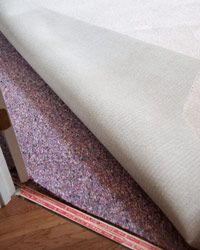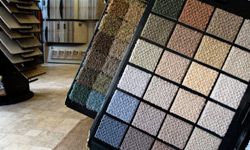Home Improvement

Carpet provides a comfortable and safe surface for kids to play and it feels soft and luxurious underfoot. Although it requires more maintenance than vinyl or tile, it offers better sound absorption, warmth, and overall comfort. With so many colors, materials, and designs available, it can be challenging to choose the perfect carpet for your home. Some materials may require frequent cleaning or have a high price tag, while others may affect your health. Choosing the wrong carpet can also lead to quick wear and tear, fading, and stubborn stains. Here are ten tips to help you choose the best carpet for your home.
10: Pick the Perfect Padding

The right padding is essential for supporting, strengthening, and cushioning your carpet. It conceals subfloor imperfections, improves the appearance of finished floors, controls the temperature of your home, absorbs sound, and supports your carpet for years. Consult with your carpet manufacturer for recommendations on padding materials, density, and thickness. High-traffic areas need firm, dense padding, while light-traffic rooms require less protection.
9: Consider Various Carpet Styles
Carpet comes in different styles like plush, Saxony, Berber, textured, and frieze. These terms refer to the surface pile created from yarn tufts that are either cut straight across or folded over into loops. While each style has a distinct look, it is important to consider how well it fits your lifestyle. Plush carpeting is thick, soft, and inviting but shows footprints and vacuum tracks, and can develop “pooling.” Saxony is similar to plush and works best in low-traffic areas like formal living rooms and master bedrooms.
Berber carpeting is a flat and dense type of carpet that is made from continuous fiber loops. It is very durable and resistant to tracks, soil and stains, which makes it perfect for high-traffic areas or places that are frequently used by children. This type of carpeting can have a level loop, cut-and-loop or multi-level loop design. Textured carpeting, on the other hand, is made from fibers that are cut to different heights, which causes them to reflect light. This makes it difficult to see tracks and dirt, which makes it great for high-traffic areas as well. Some Berbers are textured. Friezes, which are a type of cut-pile carpet, are made from slightly twisted fibers. They are less formal than plush but fancier than many textured pieces or Berber. The carpet feels soft on your feet, yet its fuzziness hides footprints and dirt well.
When choosing a carpet, it is important to consider your budget and lifestyle. Shop around to find a carpet that fits your needs and budget. Always request separate pricing for materials and installation so you can compare prices among different suppliers. Choose the best carpet for each room to make the most of your budget. Stain-resistant products may be worth the splurge in your busy family room, but more affordable low-traffic carpeting may be just fine for your guest rooms. Consider lifetime replacement and maintenance expenses to keep costs even lower. For example, if you have kids or pets, try carpet tile instead of rolled carpeting. This way, you can replace single tiles as needed to keep your carpet looking fresh and new.
When purchasing carpet, it is important to select a reputable establishment that specializes in carpeting. A quality carpet store will carry a large, varied selection of carpets, including different fiber options such as wool, synthetics, blends, sisal, linen, jute, coir and woven vinyl. Staffers should be able to easily answer all of your questions and let you take samples home. The quality of your carpet’s installation is just as important as the quality of the carpet itself. Look for stores that employ their own installers to ensure a high-quality installation. If you can’t find a good shop with its own installers, make sure your carpet dealer’s subcontractors have worked with them for many years.
6: Understanding Maintenance Needs

For those with pets or young children, a low-maintenance carpet may be the best choice.
Hemera/Thinkstock
To ensure satisfaction with your new carpet, it’s best to stick with one that’s easy to maintain. Homeowners with young children or pets may want to avoid shag or high-end rugs that are difficult to clean. Stain-resistant carpets can help with spills and reduce cleaning time.
Before committing to a purchase, always ask the salesperson about the cleaning and maintenance requirements. Find out how often the carpet needs to be cleaned and what equipment or products the manufacturer recommends. Avoid carpets with extensive maintenance requirements unless you have the extra time to perform those tasks.
The type of material and style of carpet can also impact maintenance needs. Textured rugs can conceal footprints and vacuum cleaner tracks. In high traffic areas, look for textured Saxony, level loop, or high-density loop carpets to resist dirt and make cleaning easier. Cut pile and multilevel loop carpets should only be installed in low to medium-traffic areas, as these designs tend to trap dirt and resist cleaning efforts [source: Consumer Reports].
5: Warranties
Carpeting comes with a variety of warranties, but many offer little true coverage [source: Carpet Buyers Handbook]. The better quality the carpet, the more coverage is offered. However, don’t make a purchase solely based on a warranty. For example, the most common warranty is a “wear” warranty, but the definition of “wear” may differ between the manufacturer and the homeowner. The most common carpet complaints are for improper installation, so make sure to ask about recourse if unhappy with installation before making a purchase.
4: Comparing Color and Patterns

Take your time when choosing from the wide variety of available colors and patterns.
©iStockphoto.com/fullvalue
Choosing the right finish may be the most difficult part of buying carpet, with so many colors and designs to choose from. Narrow your search by selecting shades that match the overall mood or tone you want to set for each room. Cool blues or greens can create a calm, peaceful setting, while warm reds or golden shades can make a large space feel cozier. Light colors can make small rooms feel larger and more open, so consider cream or tan if feeling claustrophobic.
Decide whether you want your carpet to be a focal point or blend into the background before settling on a neutral shade. If your walls, furnishings, or artwork serve as focal points, then going neutral can help avoid a plain, monotone design.
To hide stains, dark shades or patterns can be used, along with tweed or textured carpet designs. To ensure that patterned rugs match with other patterns in the room, stick to designs within the same color family. Using carpet tiles can provide maximum versatility by creating unique patterns and designs or adding a border around the room. Before purchasing, always ask for carpet samples of each color and examine them in natural light. Choose fade-resistant products if the carpet will be in direct sunlight as sun exposure can cause fading.
When selecting carpeting for stairs, it’s important to choose the right one as stairs receive a lot of wear and the carpeting has to bend over the edges of each step. Cut-pile carpet is a better choice than looped pile to avoid “grinning” and snagging. Density is another factor to consider, and a woven wool carpet is the ideal choice as it’s the most durable and keeps each piece of yarn in place. However, wool carpets can be expensive.
Carpeting, padding, and adhesives can impact air quality and health due to volatile organic compounds (VOCs) such as formaldehyde. To protect your family, choose carpet made from natural products like wool, jute, or other organic materials. Look for organic or chemical-free dyes to keep toxic fumes out of your home. Recycled materials like carpets made from recycled water bottles can also reduce your environmental impact. Nylon and other synthetics are made from fossil fuel byproducts, so opt for renewable or recycled products for sustainability. Consider eco-friendly carpet labeling programs like the Green Label Plus program or the Green Seal certification program for more information on the impact of different carpet options on the environment and health.
1: Choosing Between Carpeting and Area Rugs
When deciding between carpeting and area rugs, it’s important to consider their different characteristics. While carpeting is soft and warm underfoot and provides cushioning if you fall, it can also trap dust, mites, and allergens, making it problematic for those with allergies or asthma. Additionally, carpeting can be challenging to clean, retain odors, and typically needs to be replaced within a decade.
On the other hand, area rugs offer more flexibility in terms of color and design options and are often more affordable. They can also be moved from room to room and are easier to clean than carpeting. However, area rugs require a suitable base floor, as some of the underlying floor will be visible. They can also be a tripping hazard if not secured properly, but this can be mitigated with a rug pad or double-sided tape.
Additional Information
Related Articles
- 5 Tips for Eco-Friendly Carpet Cleaning
- Top 10 Flooring Mistakes to Avoid
- Top 10 Flooring Tips
- 10 Green Cleaning Tips for Your Home
- 5 Sustainable Hardwood Options
- Understanding the Professional Carpet Installation Process
- How Stain-Resistant Carpeting Works
- Choosing the Best Carpet for Allergies
- Curiosity Project: How Quickly Can Your Flooring Grow Back?
Sources
- Becker, Robin. “Choosing the Right Carpeting.” Catalogs. (Dec. 20, 2011) http://www.catalogs.com/info/rugs-flooring/choosing-carpeting.html
- Blair, Kate. “Area Rugs vs Wall-to-Wall Carpeting.” Signature Contractors. (Dec. 20, 2011) http://www.signaturecontractors.com/articles/area-rugs-vs-carpeting/174
- Carpet and Rug Institute. “A Rainbow of Choices.” Date Unknown. 09/08/2010. http://www.carpet-rug.org/residential-customers/selecting-the-right-carpet-or-rug/color.cfm
- Carpet and Rug Institute. “The Benefits of Carpet and Rugs.” Date Unknown. 09/08/2010. http://www.carpet-rug.org/residential-customers/the-benefits-of-carpets-and-rugs.cfm
- Carpet and Rug Institute. “Selecting the Right Cushion.” Date Unknown. 09/08/2010. http://www.carpet-rug.org/residential-customers/selecting-the-right-carpet-or-rug/selecting-the-right-cushion.cfm
- Carpet Buyers Handbook. “Selecting Carpet Colors.” (Dec. 20, 2011) http://www.carpetbuyershandbook.com/buying-carpet/carpet-color-selection/
- Carpet Buyers Handbook. “Understanding Carpet Warranties.” (Dec. 20, 2011) http://www.carpetbuyershandbook.com/buying-carpet/carpet-warranty/
- Carpet Cleaning Long Island NY. “Understanding Carpet Warranties.” (Dec. 20, 2011) http://www.carpetcleaninglongislandny.com/consumers/information-about-carpet-warranties/
- Carpet Solution. “Things to Consider Before You Buy Carpets.” (Dec. 20, 2011) http://www.carpet-solution.com/carpet_choosing/
- Consumer Reports. “Wall-to-Wall Carpeting.” Nov. 2007. 09/08/2010. http://www.consumerreports.org/cro/home-garden/bed-bath/home-decoration/wall-to-wall-carpeting/overview/index.htm
- Decorator Secrets. “Carpet and Area Rug Tips.” (Dec. 20, 2011) http://www.decoratorsecrets.com/carpet-area-rugs.html
- Demesne. “Choosing Quality Wall-to-Wall Carpet.” (Dec. 20, 2011) http://www.demesne.info/Improve-Your-Home/Floor-Coverings/Carpet.htm
- Direct Discount Carpet. “Five Tips for Choosing Your Carpet.” (Dec. 20, 2011) http://www.directdiscountcarpet.com/carpet-tips.aspx
- DIY Network. “Selecting the Right Carpet.” (Dec. 20, 2011) http://www.diynetwork.com/decorating/selecting-carpet/index.html
- HGTV. “Choosing the Perfect Carpet.” 2010. 09/08/2010. http://www.hgtv.com/home-improvement/how-to-choose-carpet/index.html
- Home Depot. “How to Select the Perfect Carpet.” (Dec. 20, 2011) http://www.homedepot.com/hdus/en_US//DTCCOM/HomePage/Commerce/Flooring/Carpet/Docs/105725_Carpet_Guide.pdf
- King County, Washington. “Environmentally-Friendly Carpet.” April 29, 2009. 09/08/2010. http://www.kingcounty.gov/operations/procurement/Services/Environmental_Purchasing/~/media/operations/procurement/documents/EP_Products_Carpet.ashx
- Landry & Arcari. “Ten Tips for Choosing the Right Carpeting.” (Dec. 20, 2011) http://www.landryandarcari.com/Carpet-Buying-Tips.php
- Schmidt, Mary. “Choosing the Perfect Rug.” Urban Life. 2007. 09/08/2010. http://newmedia.academyart.edu/gallery/web/7346_Web/living_choosing_rug.html
- Tremblay, K.R. Jr., and Wiliams, K. “Selecting Carpet for Your Home.” Colorado State University Extension. Dec. 2007. 09/08/2010. http://www.ext.colostate.edu/pubs/consumer/09535.html
- U.S. Environmental Protection Agency. “Introduction to Indoor Air Quality.” April 23, 2010. 09/08/2010. http://www.epa.gov/iaq/voc.html
- U.S. Environmental Protection Agency. “Creating a Green Bedroom.” Nov. 9, 2009. 09/08/2010. http://www.epa.gov/greenhomes/bedroom.htm
- WFCA. “Things You Need to Know Before Buying Carpet.” (Dec. 20, 2011) http://www.wfca.org/Pages/Before-You-Buy-Carpet.aspx
- World Floor Covering Association. “Why Choose Carpet?” 2010. 09/08/2010. http://www.wfca.org/carpet/why.aspx
FAQ
1. What factors should I consider when choosing carpet?
When choosing carpet, you should consider several factors, such as the carpet’s durability, stain-resistance, comfort, and style. You should also consider the room’s traffic level and the type of activities that will take place in the room. For example, if you have children or pets, you may want to choose a carpet that is stain-resistant and durable. Additionally, you should consider the carpet’s color and texture, as they can greatly affect the overall look and feel of the room.
2. What is the best type of carpet for high-traffic areas?
The best type of carpet for high-traffic areas is one that is durable and stain-resistant. Nylon and polyester carpets are both good options, as they are easy to clean and can withstand heavy foot traffic. Additionally, you may want to consider a low-pile or looped carpet, as they are less likely to show wear and tear over time.
3. How do I choose the right carpet color?
When choosing a carpet color, you should consider the room’s overall color scheme and the amount of natural light the room receives. Darker colors can make a room feel cozy and intimate, while lighter colors can make a room feel brighter and more spacious. You should also consider the carpet’s texture and pattern, as they can greatly affect the overall look and feel of the room.
4. What is the difference between cut pile and loop pile carpet?
Cut pile carpet is made by cutting the carpet fibers, which creates a plush, soft texture. It is a popular choice for bedrooms and living rooms, as it is comfortable to walk on. Loop pile carpet, on the other hand, is made by weaving the carpet fibers into loops. It is a more durable option and is often used in high-traffic areas such as hallways and stairs.
5. How often should I replace my carpet?
The lifespan of carpet varies depending on several factors, such as the quality of the carpet and the amount of foot traffic it receives. Generally, carpet should be replaced every 5-10 years. However, if your carpet is showing signs of wear and tear, such as fraying or staining, it may need to be replaced sooner.
6. How do I properly maintain my carpet?
To properly maintain your carpet, you should vacuum it regularly to remove dirt and debris. You should also clean up spills and stains as soon as possible to prevent them from setting in. Additionally, you should have your carpet professionally cleaned every 12-18 months to remove deep-set dirt and allergens.

Brody is a skilled craftsman and gardening expert. From renovating living spaces to cultivating lush gardens, Brody’s knowledge and passion shine through, inspiring readers to embark on their own home improvement and gardening journeys with confidence.






Leave a Reply